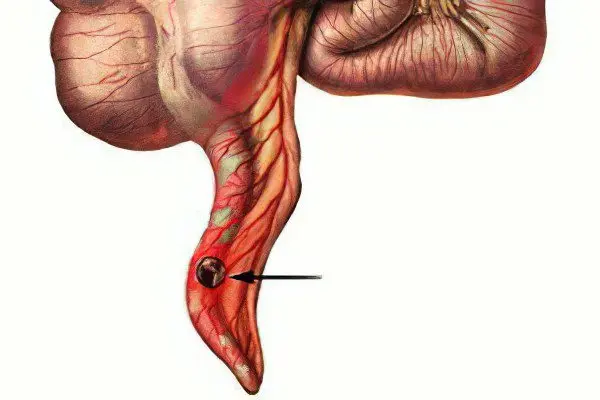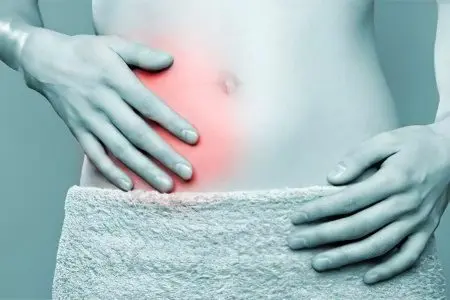Contents
What is acute catarrhal appendicitis?
Acute catarrhal appendicitis – This is a type of inflammatory lesions of the appendix. It is based on the initial stages of the inflammatory process, in which there are reversible changes in the walls of the appendix without signs of suppuration or destruction.
Causes of catarrhal appendicitis

Catarrhal appendicitis can be caused by such etiopathogenetic factors and mechanisms as:
Pathogenic microorganisms that have entered directly into the lumen of the appendix;
Intestinal infections of bacterial and viral origin. Inflammation of the appendix occurs a second time, since it is an immune organ and can respond to any infectious and inflammatory processes in the abdominal cavity;
Violations of the contractions of the appendix, which leads to the entry of feces into its cavity;
Fecal stones and undigested pieces of food. They can block the exit from the appendix, which leads to stagnation of the contents and inflammation;
Contact transition of inflammation from other organs and peritoneum.
Symptoms of catarrhal appendicitis
The clinical picture in acute appendicitis is quite specific, but there are also atypical cases of the course of the disease. According to clinical manifestations, even the best surgeon cannot say with certainty that this is catarrhal appendicitis. An accurate diagnosis can only be made after a visual examination of the appendix. The sequence of determining the symptoms of this disease consists of identifying clinical signs of appendicitis in general, and assessing the condition of the appendix during surgery or laparoscopy.
These appendicular symptoms include:
Pain in the iliac region of the abdomen on the right. Sometimes it occurs immediately in this place, and in some cases it moves to this area a few hours after the onset in any part of the abdomen (Kocher-Wolkovich symptom);
Increased pain in the right abdomen when walking;
Nausea and one-two times vomiting;
dry mouth;
Increase in body temperature;
Palpation soreness of the iliac abdomen on the right, where muscle tension (defense) is determined;
Tapping on the abdomen in the right lower sections causes increased pain (Razdolsky’s symptom);
Increased pain in the abdomen, if through a tight T-shirt or shirt, sharply run your hand across the abdomen from top to bottom on the right. A similar procedure performed on the left does not cause pain (Voskresensky’s symptom);
Visual signs of catarrhal appendicitis include swelling, tension, thickening, redness, and increased vascular pattern of the appendix. There should be neither fibrinous layers nor dark areas on its walls.
Secondary catarrhal appendicitis

In cases where the appendix becomes inflamed not due to its direct primary damage, but due to the transition of the process from other internal organs, they speak of secondary catarrhal appendicitis.
This can lead to:
Perforated ulcer of the stomach and duodenum;
Acute destructive cholecystitis;
Enteritis and enterocolitis;
Crohn’s disease (terminal ileitis);
intestinal diverticulitis;
Acute adnexitis and pyosalpings;
Peritonitis of any origin.
Secondary catarrhal appendicitis is always a finding during an operation that is performed for the underlying disease. Such inflammation of the appendix does not pose any danger, since it passes on its own as the inflammation of the peritoneum and the causative organ subsides.
Is surgery necessary?
The presence of signs of acute appendicitis, even in case of doubts about the correctness of this diagnosis, is an indication for surgical treatment. In the classic version, an appendectomy is performed (removal of the inflamed appendix). Do not hesitate or even refuse surgical treatment. Indeed, clinically appendicitis can manifest itself as catarrhal, but in the appendix there may already be destructive changes. In this case, it threatens with serious complications and consequences not only for health, but also for the life of the patient. Therefore, the diagnosis of acute appendicitis suggests surgical treatment on an emergency basis.
In the literature and everyday life, cases are described when it was possible to avoid surgical treatment in patients with obvious signs of acute appendicitis. But this is not a reason for refusing to intervene. The risk of surgery and possible consequences is simply incomparable. The exception is cases of secondary catarrhal appendicitis, in which the removal of the process is not required.










Менде жедел катаральды апендицит болды,оған аперация стеды